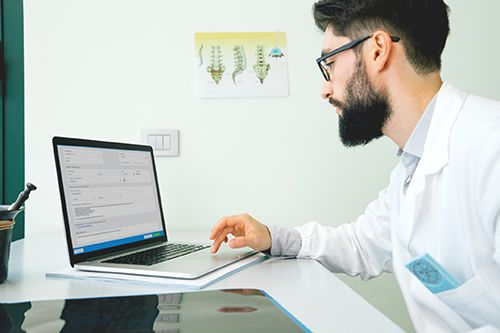Many of the physicians we speak to liken eConsults to curbside consultations but there is a tremendous difference. Curbside consultations are the most informal type of specialist consult. They occur when the physician consultant does not see the patient or review the patient’s chart. A hospitalist stopping a cardiologist in the hallway of a hospital is a great example of a curbside consult.
While physician-to-specialist consultations have been around for centuries, the advent of technology makes curbside consultations incomplete and risky for the advising physician. Technology, such as email, video conferencing, and electronic consultation provide continued care while enabling providers to document and feel confident in the advice they receive from their colleague.
As specialist consultations become increasingly popular and necessary due to the nationwide physician shortage, several subcategories of physician consultation have emerged. To understand what will benefit your practice the most, it’s important to understand the advantages and disadvantages of different physician-to-physician consultation. After all, “consult” can refer to anything from a break room chat to a documented and patient-specific knowledge sharing session.
Here are the four main types of informal and formal virtual consults and how medical professionals use them.
Informal: Curbside Consultations
Curbside consultations are fairly common. One-third of family physicians’ or PCPs’ information needs are fulfilled through informal consults. PCPs self-report receiving an average of 3.2 curbside consults per week, while subspecialists report approximately 3.6 per week.
How eConsults Increase Quality of Care
When providing advice to another physician in a curbside consultation, Protected Health Information (PHI) is not typically exchanged during a curbside consult. Rather, medical professionals pass information informally to validate, inform, or further direct care planning for a patient’s condition.
Curbside consults can help address gaps in care and expand the care capacity of many PCPs. However, inherent downsides of curbside consults include:
- Potentially inaccurate, incomplete, or biased information
- An inefficient and cumbersome process that doesn’t fit seamlessly within clinical workflows
- A lack of documentation
- Uncompensated curbside consultation work is not billable
- Curbside consults are not scalable with respect to improving access to specialty care
Informal: Email Consult
Providers often communicate and consult with one another via email. An email consult falls under the umbrella of asynchronous communication. Email consults are considered informal because they are managed from outside the electronic health record and don’t require a data review.
Email consults can help address gaps in care. They are an efficient way to communicate because their asynchronous nature means that providers can easily connect within regular workflows. Even so, the information may not be reliably transferred to the patient’s medical record. The fact that email correspondence lies outside of the EHR means inevitable gaps in care communication.
Formal: Video Consult
During a video communication consult, providers communicate via some form of videoconferencing software to exchange information about a patient. Videoconferences are informal because the response from the consulting physician is not typically formalized and information is not reliably entered into the EHR.
This form of consult is synchronous and provides the benefit of being remote. Unlike with curbside consults, providers communicating via videoconferencing software need not be in the same location at the same time.
As a synchronous form of communication, videoconferencing requires both providers to be present at the same time.
Formal: Electronic Consults or eConsults
An eConsult is a very specific type of formal asynchronous physician consult between providers. It occurs within a shared EHR or secure web-based platform whereby PHI is exchanged. This definition excludes curbside consultations, other telehealth modalities (such as videoconferencing), and electronic referral.
eConsults directly address many of the limitations encountered by other forms of consult. For instance, eConsults formalize the consultant role, occur within a secure and dedicated platform, and do not require individuals to be present simultaneously. While some of the above forms of consult may do one or more of these (for example, email correspondence is asynchronous), none meet all of these standards for a formal consult.
eConsults fill many information gaps between providers. Most commonly, eConsults are used by PCPs to request clinical input from specialist physicians on outpatient issues. However, there are many other use cases for eConsults. Inter-specialty (30% of eConsults), surgical (8.7%), and intra-specialty eConsults (7.5%) all see significant use.
In addition to use cases where providers call on other providers directly, eConsults can be integrated into workflows to automatically trigger based on conditions set by the healthcare organization.
Formal eConsults require a technology platform. eConsult efficacy can be measured using standard data and reporting methods which assess utilization of the platform and the effectiveness of improving access for PCPs and other providers.
Metrics include percent utilization rate (the percentage of routine, non-procedural referrals routed first to eConsult) and provider-reported significance to the care plan.
eConsults have a significant impact on a patient’s plan of care. They support pre-appointment workups and provide interim care guidance and diagnostics prior to a face-to-face visit with a specialist, as recommended by the consulting specialist. In addition, eConsults are billable via codes introduced by CMS in 2019.

eConsult Outcomes
Compared to informal consults, formal eConsults lead to many significant outcomes within health systems after effective implementation.
PCP satisfaction is quite high across systems with eConsult platforms. Providers cite factors such as convenience, improved access to specialty input, and shorter wait times for patients referred for face-to-face visits.
Improved timely access to specialty care is a hallmark benefit of eConsults for patients. For patients whose needs can be addressed via eConsult, they typically receive specialist input and care via their PCP within a matter of hours. This reduces wait times for patients who need face-to-face appointments by reducing the number of unnecessary in-person specialist referrals.
Healthcare organizations see more efficient use of healthcare resources. PCPs have repeatedly affirmed that eConsults often allow patients to be cared for within the primary care setting, while specialists report “fewer inappropriate clinic visits, fewer avoidable follow-up visits, and an increase in necessary follow-up visits with eConsult-based versus paper-based referrals.”
eConsults Improve Healthcare Outcomes for All Stakeholders
Formal eConsults provide a streamlined, structured method for providers to securely share PHI, eliminating many of the limitations of curbside, email, and video consults. Insufficient access to specialist care is becoming an outdated problem of the past. Efficient clinical solutions like eConsults will play a major part of the healthcare landscape well into the future.

